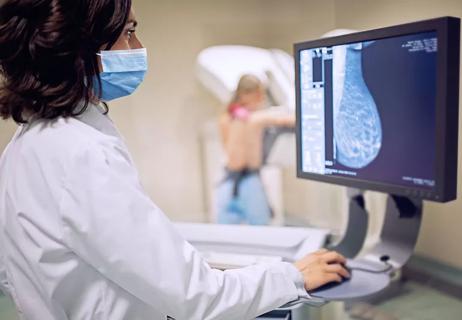Severed milk ducts or lost glandular tissue may affect your milk production

The female anatomy of a breast is incredibly complex. Filled with fatty deposits, sensitive nerves, connective tissues and glandular tissue that produce milk, there’s a lot all packed tightly together in one place.
Advertisement
Cleveland Clinic is a non-profit academic medical center. Advertising on our site helps support our mission. We do not endorse non-Cleveland Clinic products or services. Policy
If you’re pregnant or breastfeeding, any sort of previous breast surgery may have a direct impact on how much breast milk you can produce, how much can be stored in your breasts and whether or not it flows easily down mammary (milk) ducts before exiting through your nipple.
Pediatrician and breastfeeding medicine specialist Heidi Szugye, DO, IBCLC, explains some of the complications that can arise from having breast surgery, along with ways to increase and make the most of the milk supply you have.
When you have breast augmentation surgery you’re changing the appearance of your breasts with the help of implants or fat transfers. Often, a breast lift might be done in conjunction with implants to better position parts of your breast or lift them higher on your chest.
“The location, type and size of the implant can all be factors in how much milk production will be affected,” says Dr. Szugye. “But we do know that breast augmentation surgery itself can cause vascular and nerve damage and that can also affect supply.”
All breast surgeries are done in such a way as to try to reduce the effect they might have on lactation. But with breast augmentation specifically, it’s important to note that you can’t really increase the amount of glandular tissue responsible for milk production — if anything, you may lose some of that tissue as part of the process or have to rely on the tissue you’ve always had.
Advertisement
“If you have more tubular-shaped breasts or very wide-spaced breasts, that can be a sign that you were born with less of that glandular tissue that makes the milk,” explains Dr. Szugye. “Having a breast augmentation changes the appearance of your breasts, but it doesn’t increase the amount of tissue that was there to begin with.”
You can breastfeed after having breast augmentation, and breastfeeding with implants is safe. But keep in mind that the farther out from surgery that you start breastfeeding, the higher the chances that your milk supply will be sufficient.
In addition, a baby can sometimes have more difficulty latching to very large breasts, so getting support from a breastfeeding medicine specialist or lactation consultant before delivery can be helpful.
Breast reduction is different from augmentation, as the main goal is to decrease the size of your breasts by removing fat, skin and other tissues. You can breastfeed after having a breast reduction, but the procedure involves a higher chance of impacting your ability to produce breast milk because of the removal of important tissue.
“Your supply of milk is less affected if the nipple and areola remain attached to the breast during surgery,” notes Dr. Szugye.
On average, you have about nine milk ducts per nipple, and severing just one can have long-term effects on expressing milk.
“The tissue might be there and the milk might be created, but that pathway from the sacs that make the milk out to the nipple can sometimes be severed,” explains Dr. Szugye. “If the milk is produced but it has a hard time getting out, that can, unfortunately, cause some engorgement and swelling until the body recognizes the milk isn’t going anywhere.”
The process of your body ridding itself of that unused milk can take a couple of weeks, so Dr. Szugye often recommends using ibuprofen (a medication that’s safe to take while breastfeeding) and cold compresses to help reduce inflammation.
Otherwise, if you’ve had a breast reduction and are struggling to produce enough milk during feedings, you can supplement feedings with breast milk from a donor or use formula instead. In fact, there are many ways to still allow your baby to get breast milk and any amount of breast milk is beneficial.
We recommend reaching out to a breastfeeding medicine specialist during pregnancy to help maximize your breast milk supply ahead of delivery and to establish the support you need.
Advertisement
Breast cancer surgery includes the removal of small tumors (lumpectomy) and in some cases, entire breasts (mastectomy). Both surgical procedures can lead to the removal of milk ducts and glandular tissues that produce breast milk.
Radiation therapy and chemotherapy may also be used before or after surgery or even as a replacement for surgery, but that can also have a lingering impact on whether or not you’re able to produce milk that’s safe for consumption.
“If a nursing parent doesn’t need chemotherapy and just requires surgical intervention, then we’ll often try to preserve the breastfeeding experience as much as possible,” says Dr. Szugye. “We’ve had nursing parents breastfeed out of one breast if no radiation or chemotherapy is needed.”
If radiation is required, that breast won’t, unfortunately, produce milk in the future. Most chemotherapy regimens don’t allow for continued breastfeeding due to harmful effects on your baby and the risk of developing severe mastitis (inflammation of the breast) while you’re immunocompromised.
If you’ve had cancer treatments or you’re going through the treatment process, your healthcare team can discuss your options with you and help you find the support you need.
Advertisement
The key to establishing a good milk supply is getting as much milk as possible out of your breasts during the first two to three weeks after delivery.
“It’s really about supply and demand,” says Dr. Szugye. “If you’re frequently stimulating and emptying your breasts early on, we’re going to recruit all those cells that are there to make milk.”
Early on, this means you want to put your baby to your breast every two to three hours each day. Hand-expressing your breast milk after feedings can also help increase your milk supply long term.
“It’s really important early on that you’re setting yourself up for success,” encourages Dr. Szugye. “One important thing to keep in mind is that breastfeeding doesn’t need to be all or nothing, either. We can still help nursing parents reach their breastfeeding goals by maximizing their breast milk or having that at-the-breast experience.”
The breastfeeding experience is different for everyone. Generally, you want to try and maximize the amount of breast milk you can give through bottle feeding or directly from your breast, and then rely on supplementing your breast milk with FDA-approved formula as needed.
Nursing parents may also value the time that the baby is skin-on-skin with them, even if your baby isn’t getting most of their nutrition from suckling because it provides a number of other benefits.
Advertisement
“Successful breastfeeding does not always mean producing a full supply of milk,” notes Dr. Szugye. “Nurturing your baby at the breast can be fulfilling, even with the use of a supplemental feeding device.”
You can feed your baby expressed milk or formula, if needed. Supplemental nursing systems use tube feeding to help supplement milk from the breast. The system is made up of a container that has supplemental liquid. A tube runs from the container to the nipple of the breast, allowing your baby to suck on your nipple and the tube at the same time.
However you choose to supplement your supply of breast milk, it’s always good to meet with your pediatrician or a breastfeeding medicine specialist to talk about the surgeries you’ve had, any complications or challenges you’re facing, and alternative methods to breastfeeding that interest you. Doing so may lead to even better solutions along the way — and might even highlight other issues or conditions that are affecting your milk supply.
“You may have had breast surgery before, but if you also have conditions like thyroid dysfunction or polycystic ovarian syndrome or other factors that might be influencing your supply, we want to make sure those aren’t also complicating the low supply issue,” Dr. Szugye states.
“It’s always good to see a breastfeeding medicine specialist if you’ve had surgery because we can help mitigate any of the possible variables that might reduce your supply.”
Learn more about our editorial process.
Advertisement

They’re different versions of the same tool, all with the goal of early detection of breast cancer

A second appointment is common, especially after your first mammogram and if you have dense breasts — but it doesn’t necessarily mean anything is wrong

One is the gold standard for breast screening, while the other is used as a complementary diagnostic tool

Annual screenings should start at 40 for most — but some should start younger

The short answer from a radiologist

Work with your doctors to find the best approach for breast reconstruction

The short answer from a diagnostic radiologist

From faster diagnoses to less paperwork, healthcare providers are using artificial intelligence to help take better care of you

The best parenting style balances enforcing rules and showing plenty of love

Tips include cutting back on sugar, focusing on exercise and managing stress

It can be harder to let go when you’ve invested time, energy and emotions — but it might be the healthier choice long term